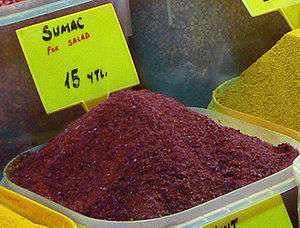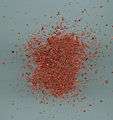Rhus coriaria
| Rhus coriaria | |
|---|---|
 | |
| Scientific classification | |
| Kingdom: | Plantae |
| Clade: | Angiosperms |
| Clade: | Eudicots |
| Clade: | Rosids |
| Order: | Sapindales |
| Family: | Anacardiaceae |
| Genus: | Rhus |
| Species: | R. coriaria |
| Binomial name | |
| Rhus coriaria | |
Rhus coriaria, commonly called Sicilian sumac,[1] tanner's sumach,[2] or elm-leaved sumach, is a deciduous shrub to small tree in the Anacardiaceae or cashew family, native to southern Europe.[3] The dried fruits are used as a spice, particularly in combination with other spices in the mixture called za'atar.
Cultivation
The plant will grow in any type of soil that is deep and well-drained.[3]
Uses
The fruit has a sour taste; dried and crushed, it is a popular spice in the Middle East.[3] Immature fruits and seeds are also eaten. It is traditionally used and also clinically investigated for lipid lowering effects.[4]
The leaves and the bark were traditionally used in leather tanning and contain tannic acid.
Dyes of various colours, red, yellow, black, and brown, can be made from different parts of the plant.[3]
Oil extracted from the seeds can be used to make candles.[3]
Medical Benefits
Scientific studies indicate Rhus coriaria is hepatoprotective[5] (protects the liver), antimicrobial[6] and exhibits a strong antioxidant activity[7] which is rich in anthocyanins and hydrolysable tannins. Unlike the similiarly named poison sumac (Toxicodendron vernix), there are no reactions from Rhus coriaria documented in medical literature.
Images
 Cultivated R. coriaria, with olive trees, in Spain
Cultivated R. coriaria, with olive trees, in Spain Spice (ground fruit) for sale in Istanbul
Spice (ground fruit) for sale in Istanbul Spice, close-up
Spice, close-up
References
- ↑ "Rhus coriaria". Natural Resources Conservation Service PLANTS Database. USDA. Retrieved 21 October 2015.
- ↑ "BSBI List 2007". Botanical Society of Britain and Ireland. Archived from the original (xls) on 2015-01-25. Retrieved 2014-10-17.
- 1 2 3 4 5 Plants for a Future database accessed August 2010
- ↑ Hajmohammadi, Zahra; Heydari, Mojtaba; Nimrouzi, Majid; Faridi, Pouya; Zibaeenezhad, Mohammad Javad; Omrani, Gholamhossein Ranjbar; Shams, Mesbah (2018). "Rhus coriaria L. Increases serum apolipoprotein-A1 and high-density lipoprotein cholesterol levels: A double-blind placebo-controlled randomized clinical trial". Journal of Integrative Medicine. 16 (1): 45–50. doi:10.1016/j.joim.2017.12.007. PMID 29397092.
- ↑ Pourahmad, Jalal; Eskandari, Mohammad Reza; Shakibaei, Rashin; Kamalinejad, Mohammad (2010). "A search for hepatoprotective activity of aqueous extract of Rhus coriaria L. Against oxidative stress cytotoxicity". Food and Chemical Toxicology. 48 (3): 854–8. doi:10.1016/j.fct.2009.12.021. PMID 20036300.
- ↑ Nasar-Abbas, S.M; Halkman, A.Kadir (2004). "Antimicrobial effect of water extract of sumac (Rhus coriaria L.) on the growth of some food borne bacteria including pathogens". International Journal of Food Microbiology. 97 (1): 63–9. doi:10.1016/j.ijfoodmicro.2004.04.009. PMID 15527919.
- ↑ Kosar, M; Bozan, B; Temelli, F; Baser, K.H.C (2007). "Antioxidant activity and phenolic composition of sumac (Rhus coriaria L.) extracts". Food Chemistry. 103 (3): 952–9. doi:10.1016/j.foodchem.2006.09.049.